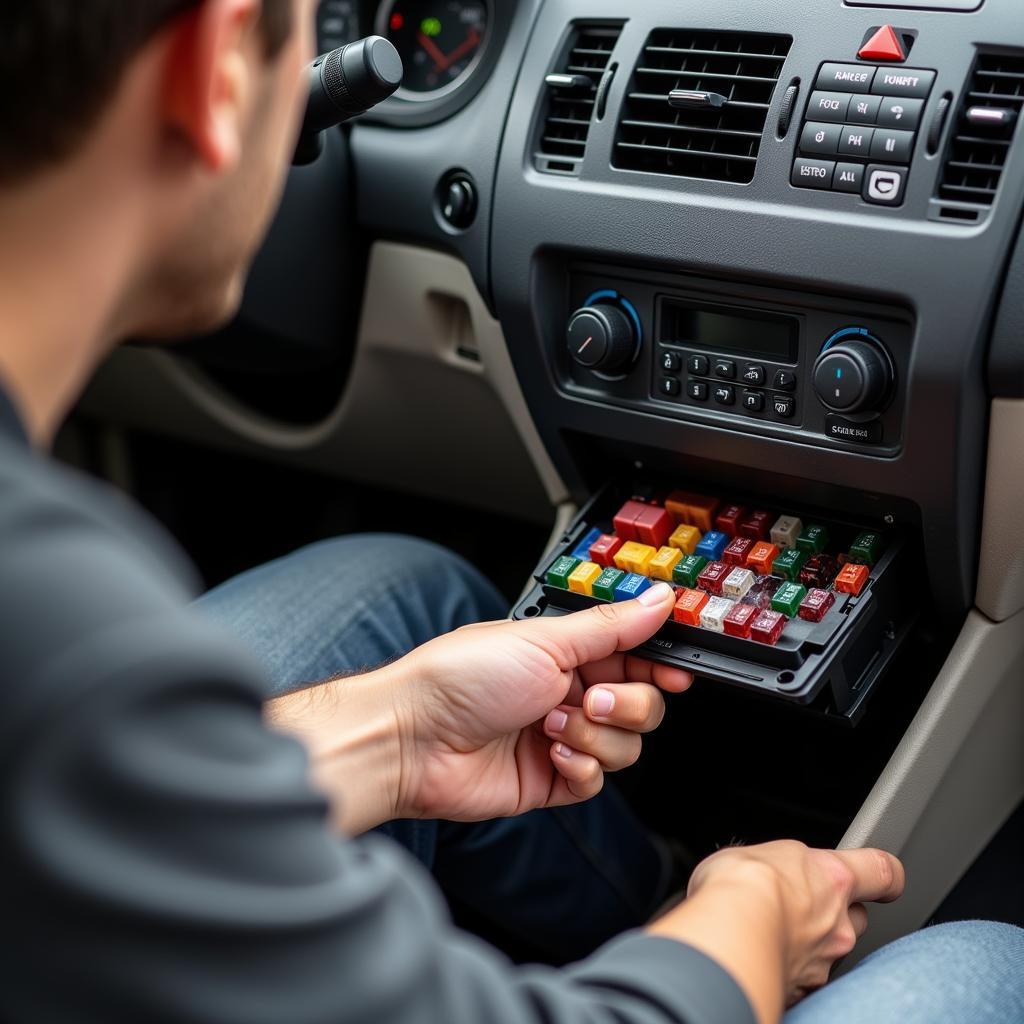A malfunctioning AC button can turn your car into a sauna on wheels, especially during scorching summers. Whether your AC button is completely unresponsive, intermittently working, or stuck, this guide will provide you with a detailed walkthrough on how to diagnose and fix the issue. We’ll cover common causes, DIY solutions, and when it’s best to call in a professional.
Understanding the AC Button and its Components
Before diving into troubleshooting, it’s crucial to understand the basic components involved when you press that AC button:
- AC Button: This is the switch that sends a signal to your car’s computer system to activate the air conditioning system.
- Blower Motor Resistor: This component controls the speed of the blower motor, which is responsible for pushing air through the vents.
- AC Relay: This electrical switch receives the signal from the AC button and allows power to flow to the AC compressor.
- AC Compressor: The heart of your AC system, the compressor pressurizes and circulates the refrigerant, which cools the air.
A problem with any of these components can lead to your AC button not working as it should.
Common Causes of AC Button Problems
Here are some of the most common culprits behind a faulty AC button:
- Blown Fuse: A blown fuse in the AC system circuit is a simple yet frequent reason for a non-responsive AC button.
- Faulty AC Relay: A malfunctioning AC relay can disrupt the power supply to the AC compressor, rendering your AC button useless.
- Electrical Issues: Wiring problems, loose connections, or a short circuit in the AC button circuitry can prevent it from sending the activation signal.
- Damaged AC Button: Wear and tear, physical damage, or spilled liquids can damage the AC button itself, making it unresponsive.
- Control Module Malfunction: In modern cars, the AC system is controlled by a complex electronic control module. A malfunctioning module can disrupt various functions, including the AC button.
 Checking car AC fuse box
Checking car AC fuse box
Troubleshooting Your Car’s AC Button
Now that you have a basic understanding of the components and common causes, let’s move on to troubleshooting the issue:
-
Check the Fuse: Locate your car’s fuse box (refer to your owner’s manual) and find the fuse related to the AC system. Inspect it for any signs of a break or burn. If you find a blown fuse, replace it with a new one of the same amperage.
-
Inspect the AC Relay: The AC relay is usually located in the fuse box or under the hood. You can test it by swapping it with a similar relay from a different system in your car. If the AC starts working, you’ve found the culprit. Replace the faulty relay.
-
Examine the AC Button: Visually inspect the AC button for any visible damage, dirt, or debris. If it appears dirty, use a cotton swab and rubbing alcohol to clean it gently.
-
Test the Blower Motor: Turn on your car’s fan. If the blower motor doesn’t run at all, it could indicate a problem with the blower motor resistor or a related wiring issue.
If these basic checks don’t resolve the issue, it’s highly recommended to consult a qualified ac car fixer near me for further diagnosis and repair.
When to Seek Professional Help
While some AC button problems can be fixed with basic DIY troubleshooting, more complex issues require professional expertise. Here are some scenarios where it’s best to seek professional help:
- You suspect a problem with the AC compressor or refrigerant.
- You’re uncomfortable working with electrical components.
- You’ve tried basic troubleshooting steps without success.
- You have limited tools and experience.
Attempting to fix complex AC problems yourself can lead to further damage and costly repairs.
Tips for Maintaining Your Car’s AC System
Regular maintenance can prevent many AC button and system problems:
- Run your AC regularly, even during winter. This keeps the refrigerant circulating and prevents components from seizing up.
- Schedule annual AC system inspections and servicing. This ensures optimal performance and can detect potential issues early on.
- Keep your car’s cabin air filter clean. A clogged filter restricts airflow and can strain the AC system.
 Mechanic inspecting car AC compressor
Mechanic inspecting car AC compressor
Conclusion
A malfunctioning AC button doesn’t have to mean a sweltering drive. By understanding the common causes and following the troubleshooting steps outlined in this guide, you can often pinpoint the problem and potentially fix it yourself. However, don’t hesitate to seek help from a qualified how to fix air conditioner in car near me if you encounter complex issues or are unsure about any step of the process. Remember, regular maintenance is key to keeping your car’s AC running smoothly and ensuring a comfortable driving experience in any weather.
For professional assistance with your car’s AC system, contact AutoTipPro at +1 (641) 206-8880 or visit our office at 500 N St Mary’s St, San Antonio, TX 78205, United States.





Leave a Reply